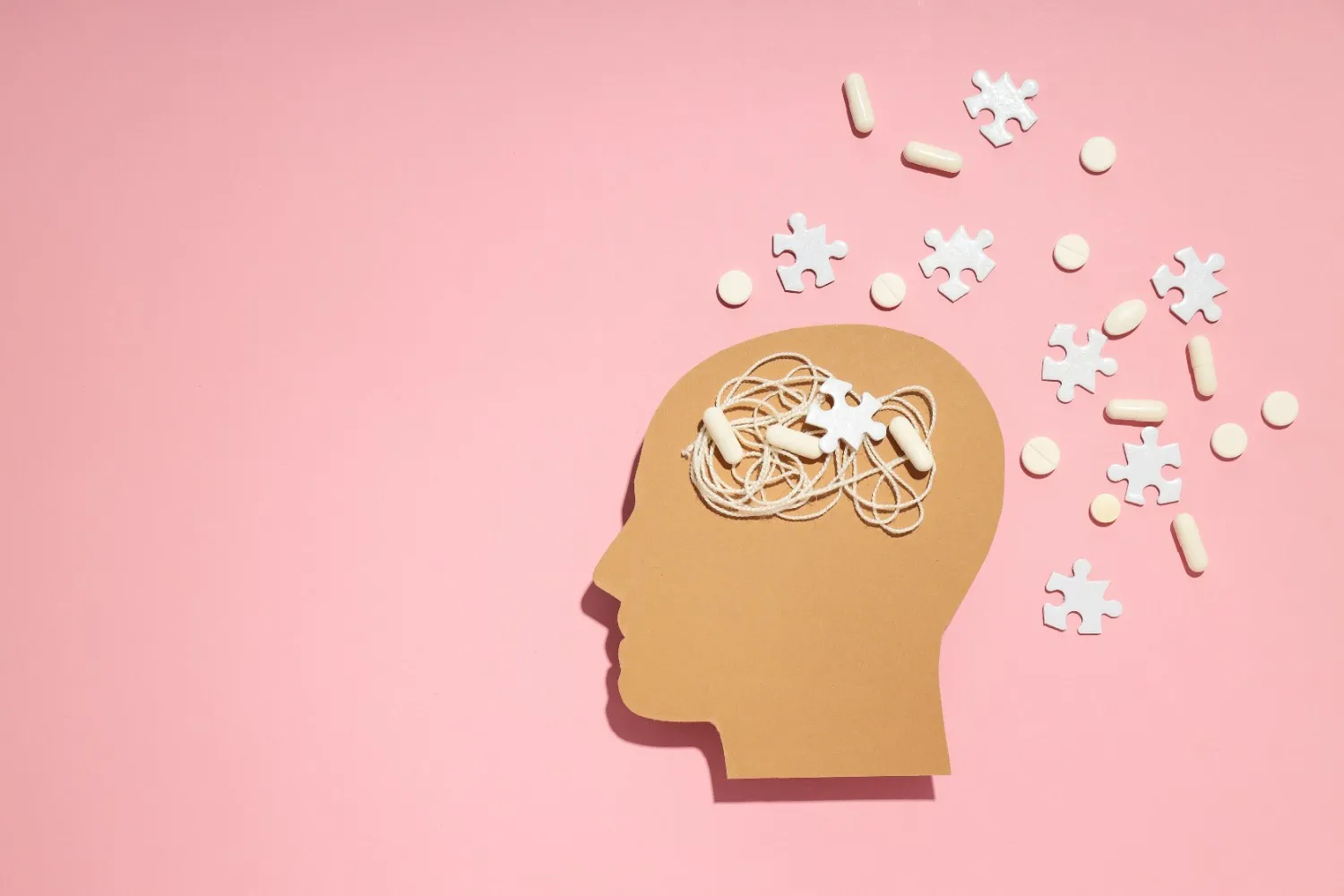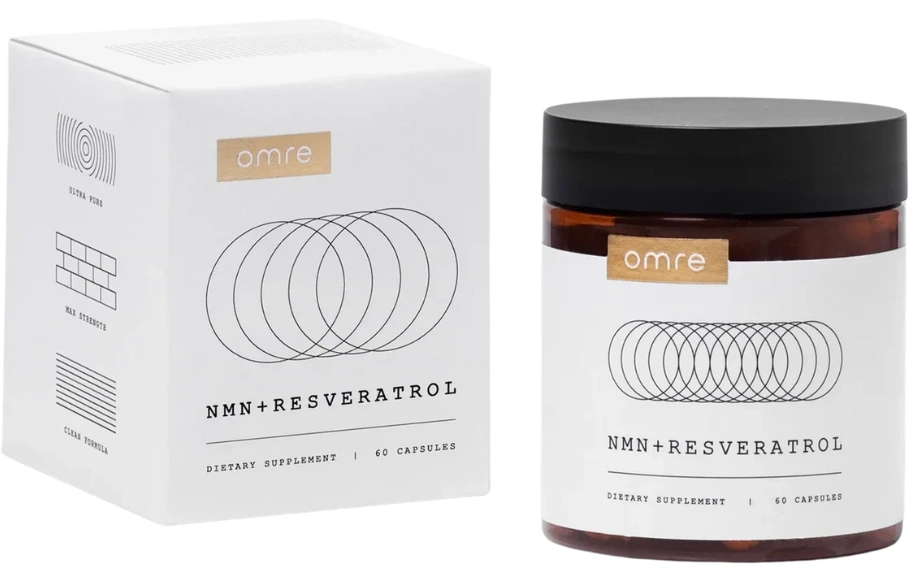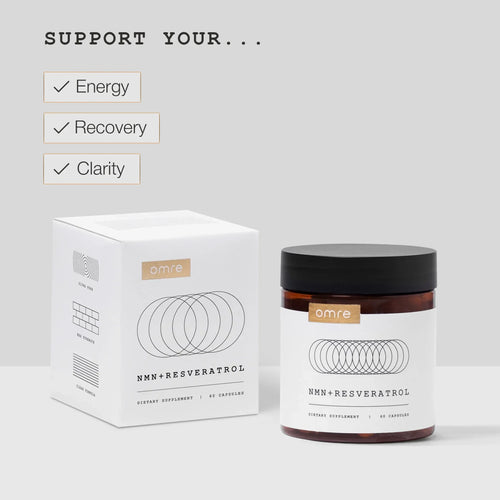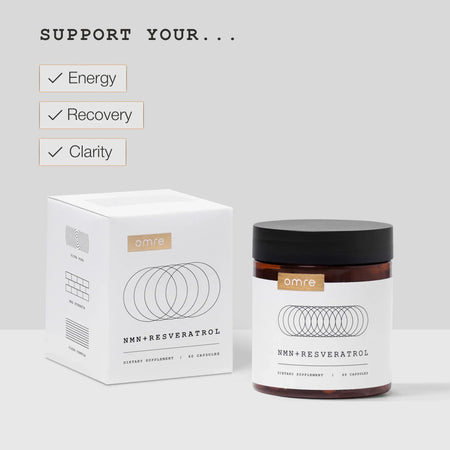Table of Contents
DNA damage symptoms like brain fog, fatigue, early aging, and higher cancer risk often show up when your cells can't repair broken genetic code.
If you're feeling off without a clear reason, DNA damage might be playing a role. Here’s what to look for and how to respond.
NMN + RESVERATROL
Cellular NAD+ booster with ultra‑pure NMN and Resveratrol, at research‑backed doses.*
TL;DR
DNA damage disrupts your cells’ ability to function and repair. It can show up as fatigue, brain fog, early aging, or higher disease risk. Your body works to fix this damage using natural repair systems, but support from NAD+ boosters like NMN can help keep those systems running strong.
What Is DNA Damage?
DNA damage is a change or break in your DNA that interrupts how your cells normally function. This can lead to errors in cell repair, cell death, or long-term disease if not corrected.
Your DNA acts like a biological blueprint. It tells your cells when to grow, divide, or rest. But this code isn’t invincible.
Everyday exposures, like UV rays, chemicals, or even natural aging, can nick, bend, or mutate DNA strands. While your body has built-in repair tools, those systems can get overwhelmed or wear down over time.
When DNA damage adds up, it can interfere with how your cells replicate and heal, raising the chances of problems like premature aging, chronic illness, or cancer (1).
That’s why spotting symptoms and understanding root causes matters.
Common Causes of DNA Damage
DNA damage can be caused by external stress, internal cell problems, or inherited conditions. Some causes are preventable; others depend on genetics or natural aging.
Now let’s break down each major category in more detail.
Environmental and Lifestyle Triggers
Environmental exposures are some of the biggest contributors to DNA damage. Here’s how:
UV radiation from sunlight or tanning beds can directly damage skin cell DNA. Over time, this raises the risk of wrinkles, sunspots, and skin cancers.
Tobacco smoke contains carcinogens that bind to DNA and cause mutations.
Air pollution and heavy metals like lead, arsenic, or mercury can create reactive oxygen species (ROS) that attack DNA strands.
Alcohol consumption, especially in large amounts, produces acetaldehyde, a toxic compound that breaks DNA and impairs repair enzymes.
Processed food and low-antioxidant diets can increase oxidative stress and reduce the nutrients needed for DNA repair.
Lack of sleep and chronic stress elevate cortisol and lower the body’s natural repair response.
Sedentary behavior slows circulation and lowers antioxidant defenses, making your cells more vulnerable to damage.
Over time, these daily choices can chip away at your DNA’s integrity, especially if you’re not getting enough protective nutrients like folate, zinc, or vitamin C.
Internal Biological Factors
DNA can also be damaged by natural processes happening inside your body, even when you live a clean lifestyle.
Oxidative stress is a major culprit. Your cells naturally produce reactive oxygen species (ROS) during metabolism. If ROS build up faster than your body can clear them, they attack DNA and other cell parts.
Errors during DNA replication are another risk. Each time a cell copies its DNA, small mistakes can happen. Usually, repair enzymes fix them, but over time those enzymes wear out or become less effective.
Mitochondrial dysfunction can also raise the chance of DNA damage. When your mitochondria (the energy centers of your cells) become less efficient, they release more ROS, which increases cellular stress.
Telomere shortening, a natural part of aging, makes DNA more fragile. Telomeres act like end caps for your chromosomes. As they shrink, your DNA becomes more exposed to breakage and mutation.
These internal triggers are hard to avoid completely, but they often build slowly, giving you time to respond through diet, exercise, and cellular support.
Medical or Genetic Conditions
Some people are born with faulty DNA repair systems or develop damage through treatments like chemotherapy.
Genetic mutations in repair genes, like BRCA1 and BRCA2, raise the risk of breast, ovarian, and prostate cancers. These genes normally help fix double-strand DNA breaks, but mutations prevent that repair.
Syndromes like Xeroderma Pigmentosum (XP) make individuals highly sensitive to UV light, leading to skin damage and cancer in childhood.
Werner Syndrome and Cockayne Syndrome are rare disorders that speed up aging due to poor DNA repair.
Ataxia-Telangiectasia affects the nervous system and immune function, increasing cancer risk and motor coordination problems.
Cancer treatments, including radiation and alkylating chemotherapy agents, work by damaging DNA in cancer cells, but they can also harm healthy cells and leave lasting genetic changes.
Autoimmune diseases like lupus can trigger DNA-targeting antibodies, damaging DNA and interfering with cell signaling.
In these cases, symptoms may appear early or build up gradually. Genetic testing or a family history of these conditions can offer important clues.
Symptoms of DNA Damage
 DNA damage symptoms can show up as fatigue, brain fog, skin problems, early aging, and increased illness. These symptoms often appear gradually and may be overlooked, but they can hint at deeper cellular stress or repair issues.
DNA damage symptoms can show up as fatigue, brain fog, skin problems, early aging, and increased illness. These symptoms often appear gradually and may be overlooked, but they can hint at deeper cellular stress or repair issues.
Depending on where the damage happens, the effects can show up in different parts of your body, like your skin, brain, immune system, or metabolism. Here’s how to recognize the signs.
Physical Signs You Might Notice
When DNA damage affects your skin, muscles, or energy systems, it often shows up as physical fatigue or changes in appearance. These signs may seem like everyday aging at first, but can be early indicators of deeper cellular trouble.
Common physical symptoms of DNA damage include:
Dry, sun-sensitive, or discolored skin
Poor wound healing or frequent bruising
Muscle weakness or aches without clear cause
Chronic fatigue or low stamina
Brittle nails or hair thinning
These signs reflect how your cells are struggling to repair and renew tissue properly.
Neurological and Cognitive Effects
Your brain cells are especially sensitive to DNA errors. When damage builds up in neurons, it can affect memory, mood, and thinking ability, sometimes long before more serious diseases appear.
Signs of DNA damage in the brain include:
Memory problems or forgetfulness
Difficulty focusing or brain fog
Mood swings or increased anxiety
Slower reaction times
Higher sensitivity to stress
These symptoms may be subtle but are worth watching if they persist or worsen over time.
Signs of Premature Aging
Some people experience aging-related issues much earlier than expected, which can be linked to underlying DNA instability. These aren’t just cosmetic, they reflect how well your cells are holding up under stress.
DNA damage-related aging signs may include:
Wrinkles or sagging skin before age 40
Early graying or hair loss
Age spots or sun damage
Joint stiffness or decreased flexibility
Declining vision or early cataracts
When your DNA repair systems slow down, the aging process often speeds up.
Increased Disease Risk
One of the biggest concerns with long-term DNA damage is that it raises your risk for serious conditions. If your body can’t repair mutations, they can accumulate and trigger disease.
Conditions linked to DNA damage include:
Frequent infections due to weak immune cells
Chronic inflammation or autoimmune flares
Hormonal imbalances affecting metabolism or fertility
Higher risk of cancers (especially skin, colon, and breast)
Metabolic disorders like diabetes or fatty liver
These risks grow over time, especially if DNA repair is slow or overwhelmed.
Diseases Linked to DNA Damage
-v1752544702698.webp) Several diseases are directly caused by faulty DNA repair or long-term DNA damage. These include rare genetic disorders as well as common age-related conditions like cancer, Alzheimer’s, and cardiovascular disease.
Several diseases are directly caused by faulty DNA repair or long-term DNA damage. These include rare genetic disorders as well as common age-related conditions like cancer, Alzheimer’s, and cardiovascular disease.
Let’s explore the key categories of DNA-related diseases and how they impact the body.
DNA Repair Deficiency Syndromes
Some rare inherited disorders involve mutations in the genes responsible for fixing DNA. People with these syndromes have trouble healing from even small bits of damage, which can lead to early illness or disability.
Examples include:
Xeroderma Pigmentosum (XP): Extreme UV sensitivity, early skin cancer, possible neurodegeneration
Cockayne Syndrome (CS): Premature aging, hearing and vision loss, developmental delays
Bloom Syndrome: Short stature, skin sensitivity, high cancer risk, poor immune function
Werner Syndrome: Early graying, cataracts, skin thinning, diabetes, short lifespan
Ataxia-Telangiectasia: Poor motor coordination, immune deficiency, blood vessel abnormalities
Age-Related Conditions
Even without inherited mutations, DNA damage adds up naturally as we age. This can trigger or worsen many common conditions later in life.
Diseases linked to accumulated DNA damage include:
Cancer: Mutated DNA can activate rogue cell growth
Alzheimer’s Disease: Neuronal DNA breaks are seen in early stages
Parkinson’s Disease: Oxidative DNA damage impairs dopamine neurons
Cardiovascular Disease: Damaged endothelial cells raise blood pressure and clot risk
Type 2 Diabetes: DNA damage in pancreatic beta cells lowers insulin production
Many of these diseases are age-associated but have DNA stress as a hidden driver. Supporting repair systems may help reduce their impact.
NMN + RESVERATROL
Cellular NAD+ booster with ultra‑pure NMN and Resveratrol, at research‑backed doses.*
How Your Body Repairs DNA Damage
Your body repairs DNA damage using built-in systems that detect and fix breaks, mismatches, and mutations before they cause lasting harm. These systems work continuously in every cell, and their efficiency plays a major role in long-term health.
While these repair processes are impressive, they’re not perfect. Over time, especially with age or chronic exposure to damage, the repair capacity can slow down.
Let’s look at how these systems work and what can help them function better.
Natural Repair Systems
Every cell has several tools to recognize and fix different types of DNA damage. Each one handles a specific repair task, like replacing broken strands or correcting replication mistakes.
Key natural repair mechanisms include:
Base Excision Repair (BER): Fixes small damage caused by oxidative stress. It removes damaged bases and fills in the correct ones.
Nucleotide Excision Repair (NER): Handles larger damage, like that caused by UV rays or chemical exposure. It cuts out and replaces full sections of damaged DNA.
Mismatch Repair (MMR): Catches copying errors during DNA replication. It keeps new cells from inheriting mistakes.
Double-Strand Break Repair (DSBR): Fixes severe breaks affecting both DNA strands. This uses two pathways—non-homologous end joining (quick fix) or homologous recombination (more accurate fix).
These repair systems are highly active in healthy, young cells, but they can slow with age, illness, or poor nutrition.
Role of Sirtuins in DNA Protection
Sirtuins are a family of proteins (SIRT1 through SIRT7) that help regulate DNA repair, inflammation, and aging. They act like cellular managers, turning on stress-response genes and stabilizing chromosomes.
Studies show that sirtuins, especially SIRT1 and SIRT6, play a key role in fixing DNA and preserving genome stability (2).
SIRT1 helps recruit repair proteins to damaged sites and activates protective pathways during oxidative stress.
SIRT6 supports base excision repair and helps maintain telomere structure, which protects DNA ends from fraying.
In a study published in Cell, researchers found that mice lacking SIRT6 aged faster and had higher levels of DNA damage, especially in brain and heart tissue (3).
Other research from the University of Rochester shows longer-lived mammals often have stronger versions of SIRT6, suggesting a link between sirtuin activity and longevity (4).
Sirtuins are also NAD+ dependent, meaning they require NAD+ to function properly. When NAD+ levels drop with age, sirtuin activity declines, which weakens the body’s ability to fix DNA.
That’s why NAD+ precursors like NMN and NR are now being explored to reactivate sirtuin repair systems.
Can DNA Damage Be Reversed?
 Some DNA damage can be repaired or reversed naturally, especially if caught early and supported through lifestyle or supplementation. But not all damage is fixable, and severe or repeated breaks may leave permanent mutations.
Some DNA damage can be repaired or reversed naturally, especially if caught early and supported through lifestyle or supplementation. But not all damage is fixable, and severe or repeated breaks may leave permanent mutations.
The good news is that your cells are always trying to fix themselves. You can support these natural defenses by giving your body the tools it needs. Here’s how:
Supporting Natural Repair
To help your cells fix DNA damage, you need to reduce stressors and feed the repair systems with proper nutrients and compounds.
Helpful ways to support DNA repair:
Use NAD+ boosters like NMN (Nicotinamide Mononucleotide) or NR (Nicotinamide Riboside). These help fuel sirtuins and other repair enzymes.
Eat antioxidant-rich foods such as berries, green leafy vegetables, and turmeric to reduce oxidative stress.
Get enough sleep to allow overnight DNA repair to happen efficiently.
Exercise regularly, which stimulates repair pathways and increases mitochondrial health.
Avoid smoking and limit alcohol, as both increase DNA-damaging free radicals.
Stay hydrated and manage stress to reduce cortisol’s negative impact on cell function.
Your body is designed to recover, but it needs the right environment and fuel to do so effectively.
Emerging Therapies and Research
Scientists are exploring new therapies to help restore DNA integrity and slow the effects of aging and disease. Some of these focus on boosting natural repair, while others target damaged cells directly.
One major area of interest is sirtuin activation. Researchers are working on compounds that enhance sirtuin function, especially SIRT1 and SIRT6.
These molecules could help delay aging, reduce inflammation, and improve repair speed. Resveratrol and pterostilbene are two natural examples being studied for this purpose.
Another promising direction is senolytic therapy, the removal of damaged or senescent cells that can no longer divide. These cells often accumulate after chronic DNA damage and release harmful signals.
By clearing them, the body may regain healthier function and reduce age-related decline. Fisetin and quercetin are being tested for their senolytic potential.
There's also growing interest in CRISPR gene editing and epigenetic reprogramming, which may one day allow scientists to correct DNA mutations directly or reset cells to a more youthful state.
While these approaches are still in early stages, they hold exciting potential.
For now, the most accessible way to protect your DNA is through lifestyle support, targeted supplements, and staying ahead of chronic stressors.
When to See a Doctor
You should see a doctor if you’re experiencing ongoing fatigue, memory issues, or unusual skin changes that don’t improve with lifestyle changes. These may be early signs of deeper DNA damage or related conditions that need professional attention.
If you have a family history of cancer, early aging, or genetic disorders, it’s also a good idea to get screened.
A healthcare provider can order tests or refer you to a genetic counselor if needed. Catching DNA repair issues early can help you take action before they turn into long-term problems.
Final Words
DNA damage happens to everyone; it’s a normal part of life. But how your body handles that damage makes all the difference.
From skin issues to brain fog and increased disease risk, the signs are often subtle but worth paying attention to.
The good news? Your body is constantly trying to repair itself. By reducing daily stressors, supporting natural repair pathways, and giving your cells the right nutrients, you can help protect your DNA and support healthier aging. If you’re ready to give your body an extra edge, Omre NMN + Resveratrol is a clean, science-backed supplement designed to support NAD+ levels, sirtuin activity, and cellular repair.
If you’re ready to give your body an extra edge, Omre NMN + Resveratrol is a clean, science-backed supplement designed to support NAD+ levels, sirtuin activity, and cellular repair.
Try it for daily energy, long-term wellness, and better protection from the inside out.
FAQs
What are the early symptoms of DNA damage?
Early signs can include brain fog, chronic fatigue, slow wound healing, or changes in skin sensitivity and tone. These symptoms often appear before more serious conditions develop.
Can DNA damage cause aging?
Yes, DNA damage is one of the main drivers of aging. It affects how cells divide and repair themselves, leading to visible aging and age-related diseases.
Is DNA damage reversible?
Mild DNA damage can often be repaired naturally by your cells. Supporting this process through NAD+ boosters, antioxidants, and healthy habits can improve outcomes.
How is DNA damage diagnosed?
There’s no single test, but genetic screening, blood panels, or imaging can detect signs of DNA instability. A doctor may also diagnose based on symptoms and family history.
What supplements help repair DNA?
Supplements like NMN, NR, resveratrol, quercetin, and antioxidants such as vitamin C or E can support DNA repair by fueling repair enzymes and reducing oxidative stress.





